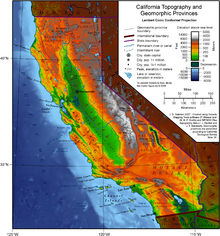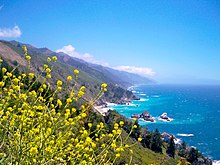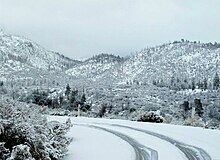California adjoins the Pacific Ocean to the west, Oregon to the north, Nevada and Arizona to the east, and the Mexican state of Baja California to the south. With an area of 160,000 square miles (414,000 km2), it is the third-largest state in the United States in size, after Alaska and Texas. If it were a country, California would be the 59th-largest in the world in area.
In the middle of the state lies the California Central Valley, bounded by the coastal mountain ranges in the west, the Sierra Nevada to the east, the Cascade Range in the north and the Tehachapi Mountains in the south. The Central Valley is California's agricultural heartland and grows approximately one-third of the nation's food.
Divided in two by the Sacramento-San Joaquin River Delta, the northern portion, the Sacramento Valley serves as the watershed of the Sacramento River, while the southern portion, the San Joaquin Valley is the watershed for the San Joaquin River; both areas derive their names from the rivers that transit them. With dredging, the Sacramento and the San Joaquin Rivers have remained sufficiently deep that several inland cities are seaports.
The Sacramento-San Joaquin River Delta serves as a critical water supply hub for the state. Water is routed through an extensive network of canals and pumps out of the delta, that traverse nearly the length of the state, including the Central Valley Project and the State Water Project. Water from the Delta provides drinking water for nearly 23 million people, almost two-thirds of the state's population, and provides water to farmers on the west side of the San Joaquin Valley. The Channel Islands are located off the southern coast.
The Sierra Nevada (Spanish for "snowy range") includes the highest peak in the contiguous forty-eight states, Mount Whitney, at 14,505 ft (4,421 m). The range embraces Yosemite Valley, famous for its glacially carved domes, and Sequoia National Park, home to the giant sequoia trees, the largest living organisms on Earth, and the deep freshwater lake, Lake Tahoe, the largest lake in the state by volume.
To the east of the Sierra Nevada are Owens Valley and Mono Lake, an essential migratory bird habitat. In the western part of the state is Clear Lake, the largest freshwater lake by area entirely in California. Though Lake Tahoe is larger, it is divided by the California/Nevada border. The Sierra Nevada falls to Arctic temperatures in winter and has several dozen small glaciers, including Palisade Glacier, the southernmost glacier in the United States.
About 45 percent of the state's total surface area is covered by forests, and California's diversity of pine species is unmatched by any other state. California contains more forestland than any other state except Alaska. Many of the trees in the California White Mountains are the oldest in the world; one Bristlecone pine has an age of 4,700 years.
In the south is a large inland salt lake, the Salton Sea. The south-central desert is called the Mojave; to the northeast of the Mojave lies Death Valley, which contains the lowest, hottest point in North America, Badwater Basin. The distance from the lowest point of Death Valley to the peak of Mount Whitney is less than 200 miles (322 km). Indeed, almost all of southeastern California is arid, hot desert, with routine extreme high temperatures during the summer. The southeastern border of California with Arizona is entirely formed by the Colorado River, from which the southern part of the state gets about half of its water.
Along the California coast are several major metropolitan areas, including Greater Los Angeles Area, the San Francisco Bay Area, and the San Diego metropolitan area.
As part of the Ring of Fire, California is subject to tsunamis, floods, droughts, Santa Ana winds, wildfires, landslides on steep terrain, and has several volcanoes. It sees numerous earthquakes due to several faults, in particular the San Andreas Fault.
Climate
California's climate varies from Mediterranean to subarctic.
Much of the state has a Mediterranean climate, with cool, rainy winters and dry summers. The cool California Current offshore often creates summer fog near the coast. Further inland, one encounters colder winters and hotter summers.
Northern parts of the state average higher annual rainfall than the south. California's mountain ranges influence the climate as well: some of the rainiest parts of the state are west-facing mountain slopes. Northwestern California has a temperate climate, and the Central Valley has a Mediterranean climate but with greater temperature extremes than the coast. The high mountains, including the Sierra Nevada, have a mountain climate with snow in winter and mild to moderate heat in summer.
The east side of California's mountains produce a rain shadow, creating expansive deserts. The higher elevation deserts of eastern California see hot summers and cold winters, while the low deserts east of the southern California mountains experience hot summers and nearly frostless mild winters. Death Valley, a desert with large expanses below sea level, is considered the hottest location in North America; the highest temperature in the Western Hemisphere, 134 °F (57 °C), was recorded there on July 10, 1913.
Ecology
California is one of the richest and most diverse parts of the world, and includes some of the most endangered ecological communities. California is part of the Nearctic ecozone and spans a number of terrestrial ecoregions.
California's large number of endemic species includes relict species, which have died out elsewhere, such as the Catalina Ironwood (Lyonothamnus floribundus). Many other endemics originated through differentiation or adaptive radiation, whereby multiple species develop from a common ancestor to take advantage of diverse ecological conditions such as the California lilac (Ceanothus). Many California endemics have become endangered, as urbanization, logging, overgrazing, and the introduction of exotic species have encroached on their habitat.







No comments:
Post a Comment